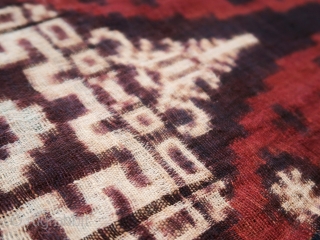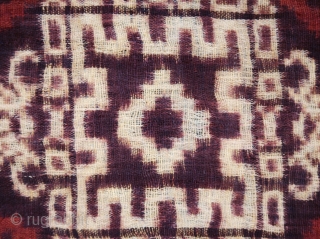Back
Balinese Double Ikat Textile (Geringsing), uncut warp
Indonesia, Bali, Tenganan Pageringsingan, Bali Aga people, mid 20th century
Handspun cotton, natural dyes, warp and weft ikat
Description: a fine example of the renowned double ikat (geringsing) sacred textiles woven in the village of Tenganan Pageringsingan in east Bali. The piece is woven in loose tabby from handspun cotton yarns dyed in botanical indigo and morinda to produce the characteristic muted colors of rust red, eggshell, and black-violet. The design condenses the pattern that has the highest prestige in Tenganan, known as geringsing lubèng, whose key motif of a powerful star motif with a stepped rectangle in the centre is esteemed as the emblem and costume of kings.
The end fields are more complex than in recent examples. a broad section has four red diamonds framing a rosette, and is filled with small crosses that are subsequently elaborated with a red centre in the final narrow section. The repetition of motifs along horizontal and diagonal axes gives the cloth great pictorial charm. The pattern is framed along the selvedge by an undyed width, and at the warp ends by plain bands of the three colours. Of crucial importance to the value of the piece is that the unwoven warp ends remain uncut, thus the textile is still in a circular form, and retains its full sacred, magical power.
Context: In Tenganan mythology, the god Indra chose the people of Tenganan to form a microcosm of the world and to use every means to keep it pure and clean. He also taught the girls and women the art of making the double ikat geringsing, which has made this tiny village world-famous (double ikat is practised only here in the Indonesian archipelago, and in 2 other places in the world). Among the many textiles used in ceremonial costumes, geringsing are the most important as symbols of the divinely ordained exclusivity of this ritual community; the cloths are believed to have magical properties that preserve the community’s existence from defilement and decay.
The lubèng design in this piece belongs to the geringsing wayang category, which have stars, emblems, architectural elements, animals, and anthropomorphic figures in the style of East Javanese temple reliefs and wayang kulit (shadow puppet drama). Geringsing textiles have long been (and are still) widely used throughout Bali in ritual and ceremonial occasions, even as fragments. Cloths with geringsing wayang patterns are seldom worn in Tenganan, but are preferred there and elsewhere over the floral type as ritual accessories in rites of passage—as a shroud, to wrap a pillow during tooth-filing, hung on sacred weapons, and placed beneath offerings.
5 widths of geringsing textiles are still woven and used in Tenganan, this being the narrowest type made of 14 strips, each consisting of 20 warp threads; the combination of all the strips makes up the complete design. These narrow cloths vary greatly in length. Geringsing wayang, if their warp fringes are uncut, are more often offered as clothing for the gods; if worn, they are used as breast-cloths by unmarried girls. (Hauser-Schaublin, Nabholz-Kartaschoff & Ramseyer, Balinese Textiles, British Museum, 1991, 116-135).
The textile appears hardly used and is in perfect condition. There are no holes, stains, or tears whatsoever. Characteristic of geringsing textiles is the fairly open weave. The cloth is quite soft; more recent examples are stiffer. The colours are warm, rich, and vibrant. Examples with the warp threads uncut are rarely found in the market.
Length: 79.5 cm (in circular form with uncut fringes). Width: 23 cm.
Indonesia, Bali, Tenganan Pageringsingan, Bali Aga people, mid 20th century
Handspun cotton, natural dyes, warp and weft ikat
Description: a fine example of the renowned double ikat (geringsing) sacred textiles woven in the village of Tenganan Pageringsingan in east Bali. The piece is woven in loose tabby from handspun cotton yarns dyed in botanical indigo and morinda to produce the characteristic muted colors of rust red, eggshell, and black-violet. The design condenses the pattern that has the highest prestige in Tenganan, known as geringsing lubèng, whose key motif of a powerful star motif with a stepped rectangle in the centre is esteemed as the emblem and costume of kings.
The end fields are more complex than in recent examples. a broad section has four red diamonds framing a rosette, and is filled with small crosses that are subsequently elaborated with a red centre in the final narrow section. The repetition of motifs along horizontal and diagonal axes gives the cloth great pictorial charm. The pattern is framed along the selvedge by an undyed width, and at the warp ends by plain bands of the three colours. Of crucial importance to the value of the piece is that the unwoven warp ends remain uncut, thus the textile is still in a circular form, and retains its full sacred, magical power.
Context: In Tenganan mythology, the god Indra chose the people of Tenganan to form a microcosm of the world and to use every means to keep it pure and clean. He also taught the girls and women the art of making the double ikat geringsing, which has made this tiny village world-famous (double ikat is practised only here in the Indonesian archipelago, and in 2 other places in the world). Among the many textiles used in ceremonial costumes, geringsing are the most important as symbols of the divinely ordained exclusivity of this ritual community; the cloths are believed to have magical properties that preserve the community’s existence from defilement and decay.
The lubèng design in this piece belongs to the geringsing wayang category, which have stars, emblems, architectural elements, animals, and anthropomorphic figures in the style of East Javanese temple reliefs and wayang kulit (shadow puppet drama). Geringsing textiles have long been (and are still) widely used throughout Bali in ritual and ceremonial occasions, even as fragments. Cloths with geringsing wayang patterns are seldom worn in Tenganan, but are preferred there and elsewhere over the floral type as ritual accessories in rites of passage—as a shroud, to wrap a pillow during tooth-filing, hung on sacred weapons, and placed beneath offerings.
5 widths of geringsing textiles are still woven and used in Tenganan, this being the narrowest type made of 14 strips, each consisting of 20 warp threads; the combination of all the strips makes up the complete design. These narrow cloths vary greatly in length. Geringsing wayang, if their warp fringes are uncut, are more often offered as clothing for the gods; if worn, they are used as breast-cloths by unmarried girls. (Hauser-Schaublin, Nabholz-Kartaschoff & Ramseyer, Balinese Textiles, British Museum, 1991, 116-135).
The textile appears hardly used and is in perfect condition. There are no holes, stains, or tears whatsoever. Characteristic of geringsing textiles is the fairly open weave. The cloth is quite soft; more recent examples are stiffer. The colours are warm, rich, and vibrant. Examples with the warp threads uncut are rarely found in the market.
Length: 79.5 cm (in circular form with uncut fringes). Width: 23 cm.
price:
SOLD
- Home
- Antique Rugs by Region
- Category
- Profiles
- Post Items Free
- Albums
- Benaki Museum of Islamic Art
- Budapest: Ottoman Carpets
- Gulbenkian Museum
- Islamic Carpets. Brooklyn
- Islamic Textiles. Brooklyn
- Konya Museum: Rugs
- MKG, Hamburg
- MMA: Caucasian Carpets
- MMA: Mamluk Carpets
- MMA: Mughal Indian Carpets
- MMA: Ottoman Carpets
- MMA: Safavid Persian Carpets
- MMA: Turkmen Rugs
- McCoy Jones Kilims
- Ottoman textiles. Met
- Philadelphia Museum
- Rugs and Carpets: Berlin
- Seljuqs at the Met
- TIEM, Istanbul: Carpets
- V&A: Classical Carpets
- Vakiflar Carpets: Istanbul
- Baluch Rugs: Indianapolis
- Gallery Exhibitions
- Jaf an Exhibition
- Alberto Levi Gallery
- Andean Textile
- Christie's London: 2016
- Francesca Galloway
- HALI at 40
- ICOC Washington, DC 2018
- Jajims of the Shahsavan
- London Islamic Week April, 2018
- Mongolian Felts
- Navajo Rugs: JB Moore
- Persian Piled Weavings
- SF Tribal & Textile Art Show 2020
- SF Tribal 2019
- Sotheby's: C. Alexander
- Turkish Prayer Rugs
- Turkmen Main Carpets ICOC 2007













